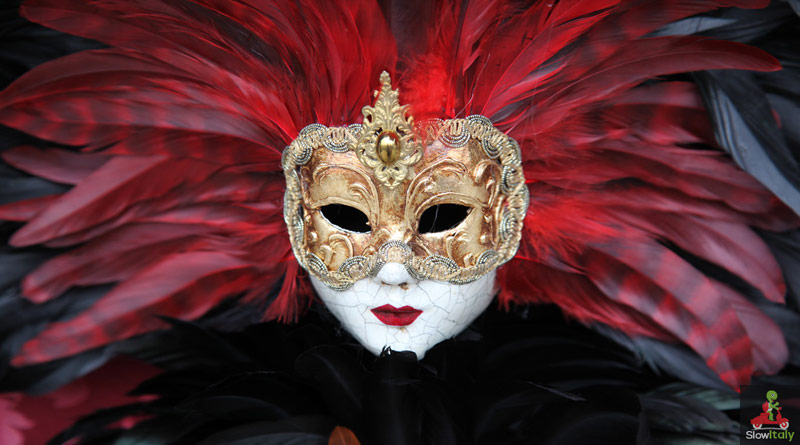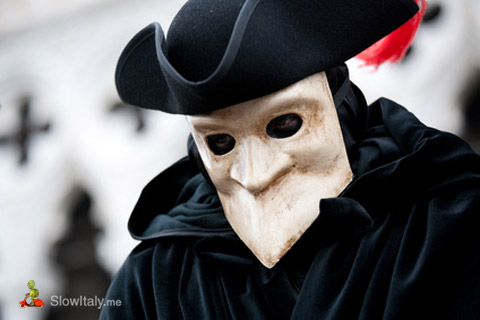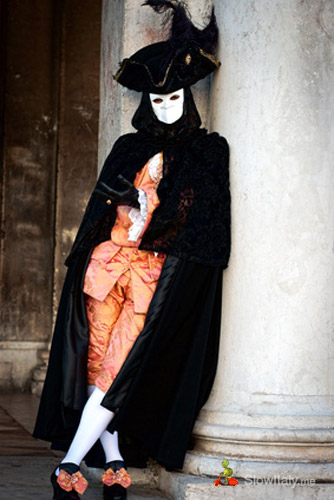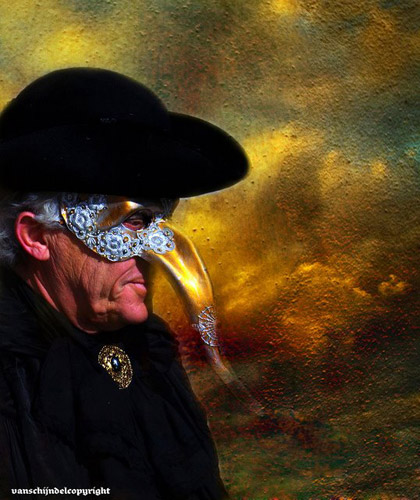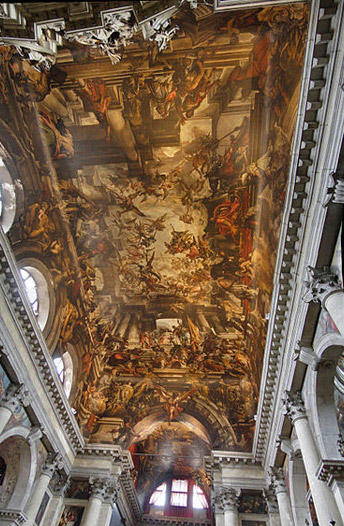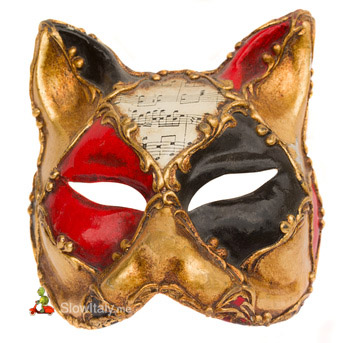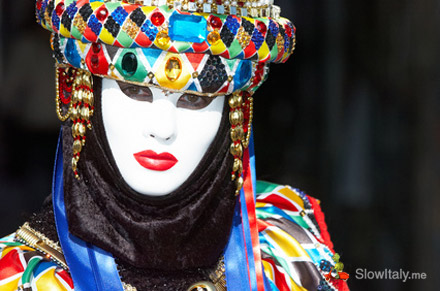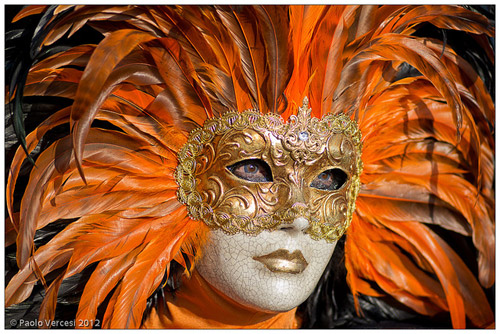Carnival of Venice: history and meaning of the different types of Venetian masks
Masks have always been an essential component of the Venetian carnival. Carnival started as a time for celebration where all social classes would mingle, and the fact of wearing a mask offered a unique possibility to remain anonymous, enjoying the advantages that such condition brought with it. In a society where social classes were very well defined and not intended to interact with each other, wearing a mask allowed to hide any form of identification based on origin, age, gender or religion.
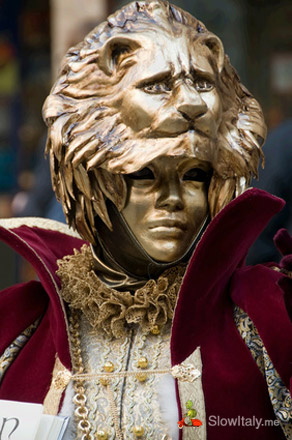
While wearing a mask was a status symbol in the Venice of the 17th century, its use was subject to strict rules. It was, for example, forbidden to wear masks outside the carnival time (and other well-defined, specific times) or in sacred places, such as churches. A man could not dress himself as a woman, and prostitutes were not allowed to wear masks in public.
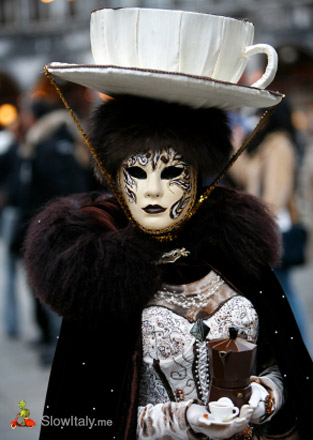
Originally Venetian masks were made of leather, porcelain or glass and had a practical or symbolic function. Today they are often made of hand-painted gesso or papier-mâché and decorated with feathers and gems.
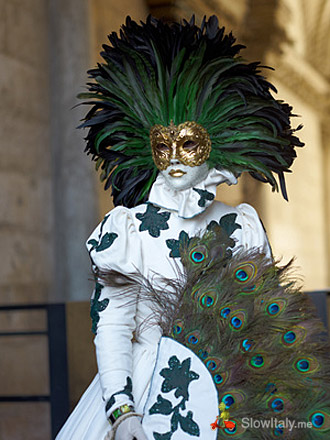
The main types of Venetian masks are the bauta, moretta, gnaga, medico della pesta, pantalone, arlechino, colombina (see further). Today, costumes worn at the Carnival vary to a certain degree from the original characters and often combine various elements of different origin.
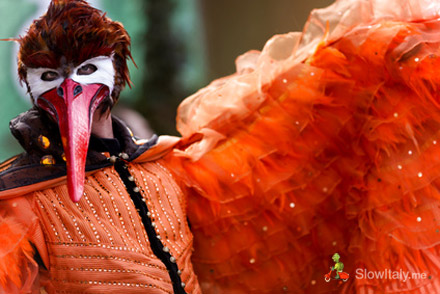
Bauta
The word bauta refers not just to a mask, but to the entire outfit, worn indifferently by men and women. The bauta was one of the most popular costumes of the Old Carnival, especially in the eighteenth century, and remained in vogue well into the modern Carnival.
The costume consists of a tricorn black hat, a veil and a tabarro, a mantle, which doubles over the shoulders, originally white, deep-blue or red in color, and decorated with frills and fringes. The mantle and veil worn with this costume made it easy to conceal arms, which forced the State of Venice to issue several decrees regulating the wearing of costumes. A very severe punishment was inflicted on any person violating these rules.
The typical mask worn with this costume is the larva, a mainly white mask whose particular shape allows the wearer to eat and drink without removing it.
Moretta
Usually worn by women, the moretta is an oval, strapless, velvet mask with no opening for the mouth, that is held in place by a button clenched between the teeth, reason why it is also called a ‘mute mask’ or servetta muta. Its name derives from the word moro which means ‘black’ in Venetian.
Medico della peste
Originally, the Medico della peste was not a carnival mask, but an outfit invented by the French physician Charles de Lorme, and worn as a protection against the plague. It is intrinsically linked to the history of Venice, as the city was hit by several plague outbreaks between 1361 and 1680. The most severe one, in 1630–31, recorded casualties of 46,000 people out of a population of 140,000. Some historians believe that the impact of the Italian plague on life and commerce was such that it ultimately resulted in the downfall of the Republic of Venice.
The Medico della peste costume consisted of an ankle length black overcoat and/or gown made from heavy fabric and usually waxed, protective gloves and a bird-like mask with a long beak. The distinctive mask was generally white with two round eyes-holes covered with glass. It had two small nose holes and acted as a kind of respirator (or primitive gas mask), filled with spices, pungent herbs, camphor and other strong aromatic substances, that supposedly purified the air plague victims had breathed. The idea was to keep away bad smells, as they were thought to be the main cause of the disease.
Several theories exist as to why plague doctors wore this bird-like costume. One theory was that the disease was spread by birds, and so the costume may have had some kind of spiritual meaning. Another explanation is that birds did not get the plague, which might have been another reason why doctors adopted this outfit. Ironically, it was precisely because of the outfit that plague doctors were less susceptible to get the disease, as the overcoat acted as a sort of cloak which prevented the fleas (the real cause of the infection) to get to the doctor’s skin.
Pantalone
Pantalone is one of the most ancient Venetian masks. His full title is Pantalone de’Bisognosi, also known as Il Magnifico, or Babilonio.
Various theories exist as to the origin of the name. One theory suggests that it is derived from San Pantaleone one of the Saints of Venice who has a church dedicated to his memory in the sestiere Dorsoduro. The church is famous for its immense ceiling painting, depicting The Martyrdom and Apotheosis of St Pantalon.
A more plausible theory is that the mask’s name derives from pianta-leone (plant-the-lion), referring to the Venetian habit to ‘plant’ their flag (bearing a winged lion as the traditional symbol of Venice) everywhere they set foot. Like the Medico della peste, il Pantalone is a character of the Commedia del’Arte. He is an old, avid and petty merchant, wearing a black mantle, woolen cap, short trousers and long, red socks (pantaloni), the typical outfit of Venetian merchants. He is portrayed with a hook nose, protruding eyebrows, a pointy goatee, while a black domino conceals half of his face.
Gnaga
A common Venetian mask is the Gnaga, part of a costume worn by men disguised as women. The traditional Gnaga outfit includes female clothing and a mask portraying a female cat.
It was often worn with a basket under the arm, which usually contained a little kitten. The person wearing the costume would usually behave like a plebeian courtesan, uttering acute sounds and mocking meows.
Arlecchino
Originally one of the most popular masks of the Commedia del’Arte, from the Bergamo basso of the 16th century, Arlecchino is now a central figure in the modern Venetian Carnival.
Colombina
The sweetheart of Arlecchino, Colombina (also known as Arlecchina), is not a true mask, as the Servetta wears her own face or, more rarely, a half-mask, only assuming the costume and dialect of the region she chooses to represent.
Twice daily during the Carnival of Venice a Best Masked Costume Contest takes place on Piazza San Marco. Competitors parade on stage, challenging each other with their masks, costumes, feathers, wigs and caps.
Related articles:
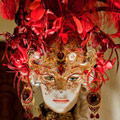
Top 10 Italian towns where to celebrate carnival
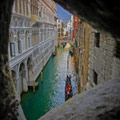
Venetian bridges with the most unusual names
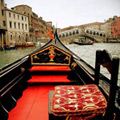
Squero San Trovaso: where Venetian gondolas are born
References:
Encyclopedia of Plague and Pestilence by George C. Kohn (ed.), Facts. on File, Inc., New York, 1995.
Photo credits (top to bottom): lion © Luciano De Faveri; peacock feature costume © Lovrencg; cappuccino costume © mandymin; orange feathers costume by Paolo Vercesi; bird © edouarrr ; bauta © missiaja; plague doctor by JanvanSchijndel; Pantalone church by Divot; Gnaga © neirfy; Arlecchino © Lovrencg.

